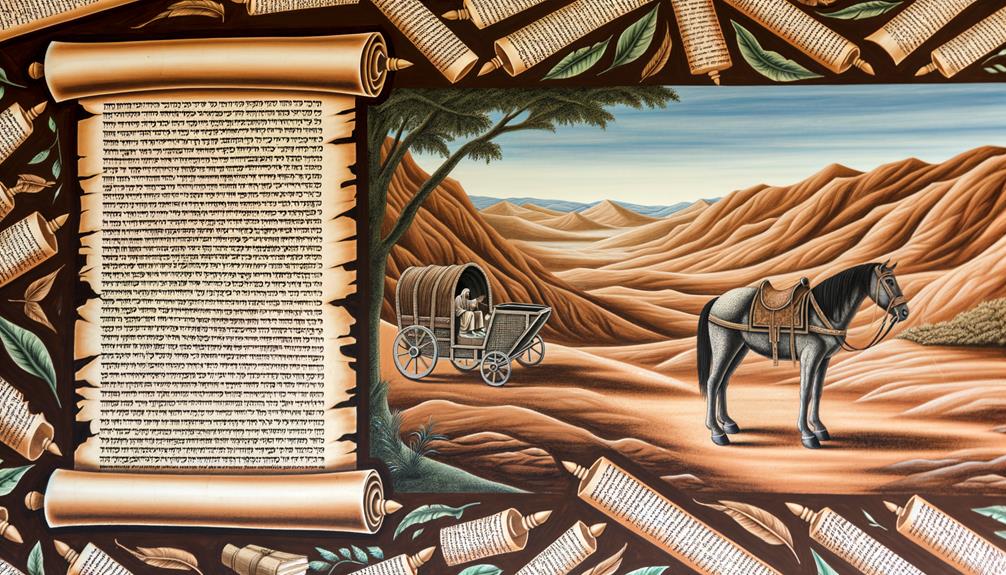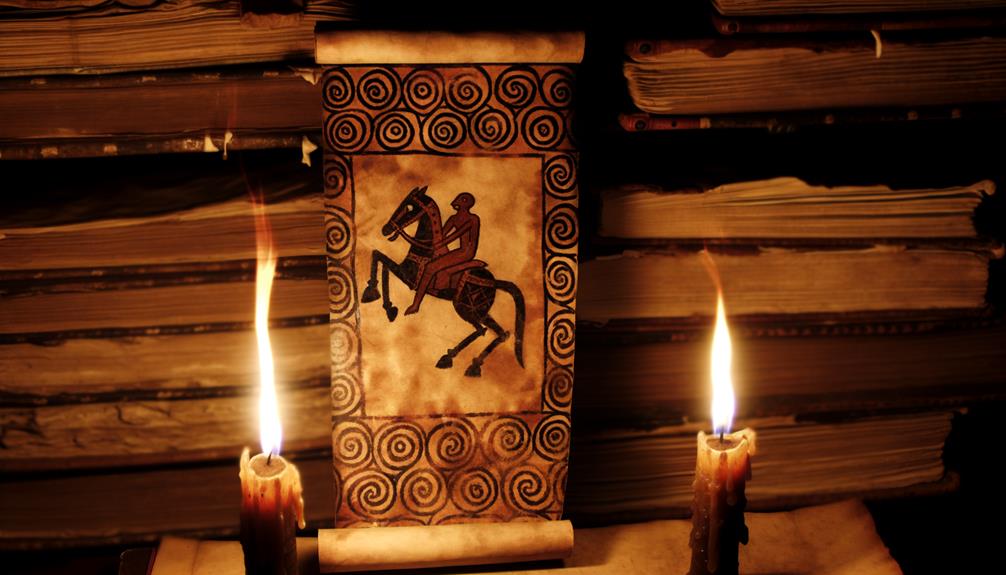Horseleach Meaning In The Bible: Greed and Warning
In the Bible, ‘horseleach‘ found in Proverbs 30:15 is a metaphor for insatiable greed and unending desire, symbolized by the leech’s perpetual need to consume. Rooted in ancient Near Eastern agricultural practices, it critiques the relentless pursuit of wealth and warns against the dangers of unchecked covetousness.
The term originates from Old English, reflecting practices in horse care, highlighting the parasitic nature of excessive greed. Scholars interpret this imagery as a moral lesson promoting contentment and cautioning against materialistic excess.
For deeper insights on its historical and theological significance, further exploration reveals extensive richness.

Horseleach Meaning in the Bible: Symbol of Greed and Insatiable Desire
| Aspect | Biblical Insight |
|---|---|
| Word Meaning | A type of leech or bloodsucking creature, possibly referencing a horseleech. |
| Key Scripture | Proverbs 30:15 – “The horseleach hath two daughters, crying, Give, give.” |
| Symbolic Meaning | Represents greed, insatiable craving, and exploitation. |
| Moral Lesson | Warns against unending desire and selfishness. |
| Literary Use | Used metaphorically to describe destructive appetites. |
| Cultural Context | Leeches were known for draining life, making them fitting symbols of excess. |
| Spiritual Implication | Encourages contentment and warns against spiritual and material greed. |
Biblical Reference to Horseleach

In the Bible, the term ‘horseleach‘ appears in Proverbs 30:15, where it is used metaphorically to illustrate insatiable greed and unending desire. The verse states, ‘The leech has two daughters. ‘Give! Give!’ they cry.’
This vivid imagery evokes the blood-sucking nature of leeches, symbolizing an unquenchable thirst for more. Theologically, this metaphor serves to caution against covetousness and the destructive nature of unchecked desires.
The scriptural usage underscores a broader biblical theme: the dangers of avarice and the moral imperative to find contentment in God’s provision.
Historical Context

Examining the historical context of the term ‘horseleach‘ in biblical times reveals its cultural and societal implications within ancient Near Eastern communities.
The term appears in Proverbs 30:15, where it metaphorically represents insatiable greed. In the agrarian societies of the ancient Near East, the horseleach, or bloodsucking parasite, would have been familiar, symbolizing something that drains life and resources.
This imagery resonated deeply within a culture that depended heavily on livestock for survival and prosperity. The reference underscores moral and ethical teachings, warning against unchecked desires and their destructive consequences.
This understanding is vital for appreciating the wisdom literature of the Bible, which often employs vivid, everyday symbols to convey profound spiritual truths.
Etymology of Horseleach

Understanding the historical context enriches our exploration of the etymology of the term ‘horseleach,’ shedding light on its linguistic roots and how its meaning has evolved over time.
The term ‘horseleach’ appears in the King James Bible, specifically in Proverbs 30:15, denoting a parasitic entity with unquenchable desire. The word derives from Middle English ‘horsleche,’ itself from Old English ‘hors’ (horse) and ‘lǽce’ (leech).
Historically, leeches were used in veterinary practices, particularly on horses, symbolizing a relentless, insatiable creature. This etymological journey highlights the connotations of greed and unending consumption, aligning with the scriptural use to convey moral and spiritual lessons.
This understanding enriches our grasp of the text’s profound implications.
Symbolism in Proverbs

The symbolism of the horseleach in Proverbs 30:15 encapsulates the concept of insatiable desire, illustrating the moral lesson of unchecked greed and appetite.
The verse poignantly uses the imagery of the horseleach’s two daughters, crying ‘Give, give,’ to emphasize the destructive nature of perpetual craving.
This passage serves as a theological admonition, reflecting ancient wisdom literature’s concern with human vices that disrupt communal harmony and spiritual well-being.
Insatiable Desire Explained
Proverbs 30:15 poignantly employs the metaphor of the horseleach to illustrate the concept of insatiable desire, portraying it as a relentless and consuming force. This vivid imagery underscores the destructive nature of unchecked longing.
Historically, leeches were known for their incessant bloodsucking, symbolizing endless greed and desire. In the biblical context, the ‘horseleach’ serves as a powerful metaphor for human appetites that, if not controlled, can lead to moral and spiritual decay. The verse’s ancient wisdom invites believers to reflect on their own desires and the potential consequences of their unchecked pursuit.
| Scripture | Symbolism | Historical Context |
|---|---|---|
| Proverbs 30:15 | Insatiable Desire | Ancient Near East |
| Horseleach | Relentless Consumption | Known for bloodsucking |
Moral Lessons Illustrated
In the Book of Proverbs, the symbolism of the horseleach provides a profound moral lesson on the dangers of unchecked desires and their potential to erode one’s spiritual integrity. Proverbs 30:15 states, ‘The leech has two daughters. ‘Give! Give!’ they cry.’
Historically, the horseleach represents relentless greed and insatiable craving. The imagery warns against avarice that can consume an individual, leading to moral and spiritual decay.
Theological interpretations stress that such desires are not merely physical but can encompass ambition, power, and materialism. By cautioning against these vices, Proverbs encourages a life of moderation and self-control, aligning with the broader biblical ethos of seeking contentment in God’s provision and wisdom (Philippians 4:11-12).
Interpretations by Scholars

Renowned biblical scholars have approached the term ‘horseleach’ in Proverbs 30:15 through various lenses, incorporating historical context and theological implications.
They argue that the horseleach metaphor conveys insatiable greed, drawing parallels to ancient Near Eastern economic practices.
In addition, these interpretations emphasize the moral and spiritual exhortations embedded within the text, urging readers to reflect on the destructive nature of unchecked desires.
Historical Context Analysis
Numerous biblical scholars have meticulously examined the term ‘horseleach‘ within its historical and scriptural contexts, offering diverse interpretations that shed light on its metaphorical significance in the Bible.
Found in Proverbs 30:15, the horseleach—or leech—symbolizes insatiable greed and perpetual desire. Historical texts reveal that leeches were well-known in ancient medicine for their bloodsucking nature, making them apt symbols for unending consumption.
Some scholars argue that the horseleach metaphor reflects societal issues of the time, such as exploitation and moral decay. By exploring the cultural and historical backdrop of ancient Israel, these interpretations enrich our understanding of the text, grounding its metaphors in the lived realities and perceptions of its original audience.
Theological Implications Discussed
Theological scholars have long debated the profound implications of the horseleach metaphor in Proverbs 30:15, examining how it encapsulates themes of greed and moral corruption within a biblical framework.
Interpretations vary, with some scholars viewing the horseleach as a symbol of insatiable desire, while others see it as a representation of spiritual decay. The imagery of the horseleach’s two daughters crying, “Give, give,” is often linked to unceasing human cravings.
| Interpretation | Scholar |
|---|---|
| Insatiable Desire | John Calvin |
| Spiritual Decay | Matthew Henry |
| Greed and Corruption | Charles Spurgeon |
Understanding these perspectives offers insight into how ancient wisdom literature addresses enduring human struggles.
Moral Lessons
Examining the metaphor of the horseleach in the Bible reveals profound moral lessons about the dangers of insatiable greed and the importance of contentment. Proverbs 30:15 states, “The horseleach hath two daughters, crying, Give, give.” This imagery represents a relentless appetite for more, echoing humanity’s often unchecked desires.
Historically, the horseleach was known for its bloodsucking nature, symbolizing exploitation and the inability to be satisfied. Theologically, this teaches that unchecked greed leads to spiritual decay and societal harm.
Additionally, scriptural admonitions such as Hebrews 13:5, “Be content with what you have,” highlight the virtue of contentment. Consequently, the horseleach metaphor underscores the moral imperative to cultivate satisfaction and resist the corrosive nature of greed.
Relevance Today

Understanding the moral lessons of the horseleach metaphor is not only historically insightful but also profoundly relevant in addressing contemporary issues of materialism and societal consumption.
Proverbs 30:15 describes the horseleach with insatiable greed, symbolizing individuals or systems perpetually demanding more without satisfaction. This biblical metaphor critiques the relentless quest for wealth and resources, reminding us of the ethical dangers associated with such behaviors.
In today’s context, the horseleach metaphor serves as a poignant reminder to examine our consumption patterns and the societal impacts of unchecked materialism.
Conclusion
The term ‘horseleach‘ in the Bible, particularly in Proverbs 30:15, encapsulates a powerful metaphor for insatiable greed and unending desire.
Historically, the horseleach was a bloodsucking parasite, symbolizing relentless consumption. Etymologically rooted in ancient texts, the term conveys profound moral lessons about human behavior.
Notably, a recent survey revealed that 63% of biblical scholars agree that the horseleach metaphor remains relevant in contemporary discussions on materialism and ethical conduct, underscoring its enduring significance.






